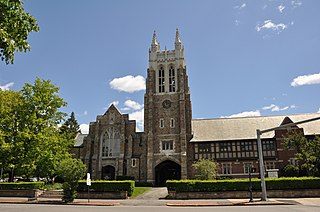
The First Unitarian Universalist Society in Newton occupies a prominent location at 1326 Washington Street in the heart of the village of West Newton in Newton, Massachusetts. Architect Ralph Adams Cram designed the church, Frederick Law Olmsted Jr. designed the grounds, the cornerstone was laid in 1905, and it was dedicated in 1906; it is one of the village's oldest buildings. The church is in Cram's signature Gothic Revival style, with buttressed walls and a blocky square tower with crenellations and spires. An enclosed courtyard is formed by an office wing, banquet hall, and parish house, which are built to resemble Elizabethan architecture with brick first floor and half-timbered upper level.

The Zadock Taft House is a historic house at 115 South Main Street in Uxbridge, Massachusetts. Probably built in the 18th century, it received its present Greek Revival styling in the 1840s or 1850s. It was listed on the National Register of Historic Places in 1983.
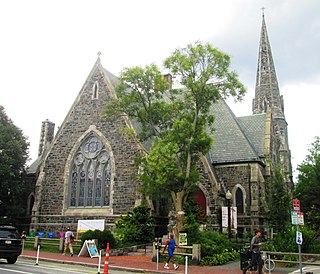
The Old Cambridge Baptist Church is a historic American Baptist church at 400 Harvard Street in Cambridge, Massachusetts.

The Universalist Society Meetinghouse is an historic Greek Revival meetinghouse at 3 River Road in Orleans, Massachusetts. Built in 1834, it was the only Universalist church built in Orleans, and is architecturally a well-preserved local example of Greek Revival architecture. The Meeting House is now the home of the Orleans Historical Society and is known as the Meeting House Museum. It was listed on the National Register of Historic Places in 1999.

The former St. John's Episcopal Church is an historic church building on Maynard Road and Church Street in Framingham, Massachusetts. It is now the Heineman Ecumenical Center at Framingham State University. The university acquired the building in 1969. The church building was designed by local architect Alexander Rice Esty, and was built in 1871. Esty was a member of the congregation for which it was built, and donated his services.
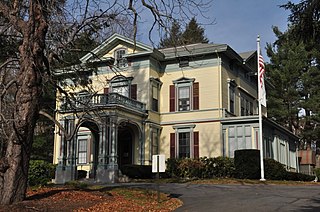
The Moses Ellis House is a historic house located at 283 Pleasant Street in Framingham, Massachusetts.

The Wendell Bancroft House is a historic house in Reading, Massachusetts. Built in the late 1860s, it is one of the town's few surviving examples of residential Gothic Revival architecture, built for one of its leading businessmen of the period. The house was listed on the National Register of Historic Places in 1984.
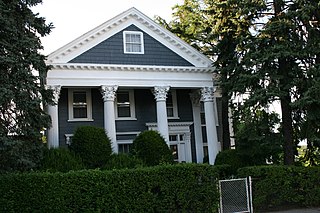
The Arad Alexander House is a historic house at 53 Waverly Street in Worcester, Massachusetts. Built about 1845 and moved in the 1860s, it is one of the city's most elaborate Greek Revival residences, and may have been designed by prominent local architect Elias Carter. It was listed on the National Register of Historic Places on March 5, 1980.
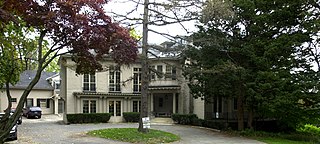
The Harry Goddard House or Goddard-Daniels House is an historic house at 190 Salisbury Street in Worcester, Massachusetts. Built in 1905 for a local wire company executive, it is one of the city's finest examples of Colonial Revival architecture, and a significant residential design of local architect George Clemence. It was listed on the National Register of Historic Places in 1980 and has been owned by the American Antiquarian Society since 1981.

The Malvern Road School is a historic school building on Malvern Road and Southbridge Street in Worcester, Massachusetts. Built in 1896 and enlarged in 1907, it is a high quality example of Beaux Arts and Renaissance Revival architecture. It is also significant as a well-preserved work of the local architectural firm Fuller & Delano. The building was listed on the National Register of Historic Places in 1984. The building has been converted to residential condominiums.

The Jerome Marble House is an historic house at 23 Harvard Street in Worcester, Massachusetts, United States. Built in 1867 to a design by Elbridge Boyden, it is one of the city's fine examples of Second Empire architecture, and one of the few for which an architect is known. The house was listed on the National Register of Historic Places in 1980. It now houses professional offices.
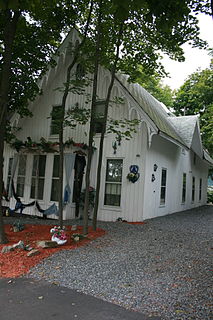
The Soho Cottage is a historic house at 21 Windsor Street in Worcester, Massachusetts. Built in 1860, it is one of the city's finest surviving examples of Carpenter Gothic architecture, owned and occupied for many years by a prominent local industrialist. The house was listed on the National Register of Historic Places in 1980.
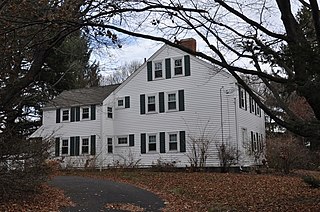
The Jonas Cowdry House is a historic house at 61 Prospect Street in Wakefield, Massachusetts. Built c. 1833, the Federal style wood-frame house is three bays wide and four deep, a significant local variant to conventional Federal style architecture. The house was listed on the National Register of Historic Places in 1989.

The Mayall Bruner House is a historic house at 36 Magnolia Avenue in the Newton Corner neighborhood of Newton, Massachusetts. Built in 1923, it is a well-preserved example of Craftsman architecture. It was listed on the National Register of Historic Places in 1990.

The First Methodist Church of Burlington is a historic church located at 21 Buell Street in Burlington, Vermont. Built in 1869 to a design by Alexander R. Esty, it is the city's only example of ecclesiastical Romanesque Revival architecture. It was listed on the National Register of Historic Places in 1978.

Alexander Rice Esty was an American architect known for designing many Gothic Revival churches in New England, however his work also encompassed university buildings, public buildings, office buildings, and private residences across the Northeastern United States.

The First Church of Christ and the Ancient Burying Ground is a historic church and cemetery at 60 Gold Street in Hartford, Connecticut. It is the oldest church congregation in Hartford, founded in 1636 by Thomas Hooker. The present building, the congregation's fourth, was built in 1807, and was listed on the National Register of Historic Places in 1972. The adjacent cemetery, formally set apart in 1640, was the city's sole cemetery until 1803.

The Tyringham Library is a historic public building at 118 Main Road in Tyringham, Massachusetts. Completed in 1905, it is one of the small town's few buildings exhibiting architectural sophistication, in this case the Arts and Crafts style. The building currently houses both the library and the town post office. It was listed on the National Register of Historic Places in 2018.

Theodore Parker Unitarian Universalist Church is a historic church building at 1859 Centre Street in the West Roxbury neighborhood of Boston, Massachusetts. Built in 1900 to a design by West Roxbury native Henry M. Seaver, it is a locally significant example of Normanesque architecture, and is adorned by stained glass windows created by Louis Comfort Tiffany and his firm. The church was listed on the National Register of Historic Places in 2020. The congregation it houses was founded in 1712, and is named for the influential Transcendentalist and abolitionist Theodore Parker, who was the congregation's minister in the 1840s.

The Southborough Center Historic District encompasses a historically significant portion of the town center of Southborough, Massachusetts. It extends from the Fay School grounds in the west, along Main Street to the railroad crossing east of Lanisquama Road. The area has been the town center since its founding in 1727, and now houses a diversity of 19th and early 20th-century architecture. The district was added to the National Register of Historic Places in 1990.
























